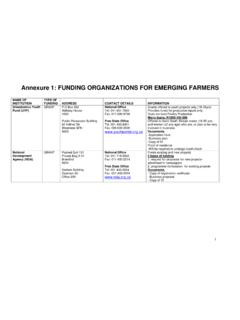Transcription of PRODUCTION GUIDELINE • SSweet pepper weet …
1 Agriculture,forestry & fisheriesDepartment: Agriculture, Forestry and FisheriesREPUBLIC OF SOUTH AFRICA PRODUCTION GUIDELINE Sweet pepper Sweet pepper (Capsicum annuum)March 2013 Department of Agriculture, Forestry and Fisheries PRODUCTION GUIDELINE Sweet pepper Sweet pepper ((Capsicum annuumCapsicum annuum))2013 Printed and published by Department of Agriculture, Forestry and FisheriesCompiled by Directorate: Plant PRODUCTION Private Bag X250 PRETORIA 0001 Tel. +27 12 319 6072 Fax +27 12 319 6372 E-mail and layout by Directorate Communication ServicesCONTENTCONTENTG eneral aspects.
2 1 Cultivation practices .. 5 Post-havest handling .. 17 PRODUCTION schedule .. 18 Utilisation .. 19 References .. 201 GENERAL ASPECTSGENERAL ASPECTSC lassifi cationScientific name: Capsicum annuumCommon names: bell pepper , sweet pepperOrigin and distribution Sweet peppers (Capsicum annuum L.) originate from central and South America where numerous species were used centuries before Columbus landed on the continent (Manrique, 1993). The cultivation of peppers spread throughout Europe and Asia after the 1500s.
3 Although perennials, they grow as annuals in temperate climates. They are sensitive to low temperatures and are relatively slow to establish. Greenhouse PRODUCTION provides most of the local source of this product. Major PRODUCTION areas in South AfricaSouth AfricaThis crop is grown in different parts of South Africa along with a large vari-ety of other vegetable and field crops on individual farms, namely Gauteng (in the highveld and lowveld areas), Northern Cape, Eastern Cape, Western Cape, Limpopo and requirementsMost sweet peppers are bell-shaped, therefore the name bell pepper is common.
4 However, sweet peppers come in a range of shapes from round to oblong, to tapered. The skin is smooth and shiny and can be a range of colours. Most peppers are green when immature, and red if allowed to ripen. However, new cultivars offer both mature and immature peppers in red, yellow, orange, purple, or of the plantThese are tender annuals or perenni-als from South America. They are green at first and change to red, yel-low or purple. They contain many flat, kidney-shaped, white seeds, which are very hot tasting. When the fruit is 2ripe it is red or yellow, but it is used as a vegetable in the green stage.
5 Although these plants are technical-ly perennials, they are not worth keeping after fruiting once. It is bet-ter to start new plants every PRODUCTION of peppers is based on indeterminate cultivars in which the plants continually de-velop and grow from new meristems that produce new stems, leaves, flowers and fruit. In comparison, field pepper cultivars are determinate; the plant grows to a certain size, produces fruit and stops growing and eventu-ally dies cultivars require constant pruning to manage their growth.
6 In order to optimise yield, a balance between vegetal (leaves and stems) and generative (flowers and fruit) growth must be established and maintained. RootsBy the end of the season, the pepper s roots may extend 20 to 30 cm deep and at least as wide, but they remain fairly fine. pepper s roots are deeper than those of lettuce, broccoli or spinach; however, they remain fairly close to the There are many different varieties of peppers ranging from 30 to 90 cm leaves are oval and taper to a point. They are usually bright to dark green, but can also be mottled.
7 The size of the leaf corresponds somewhat to the size of the fruit; plants that produce very small pep-pers also tend to have small leaves, while the larger bell pepper cultivars have large, broad have straight, woody stems and single, star-shaped, white flowers in the axils of the leaves. The flowers are followed by juiceless berries or pods, which vary in shape and size. FruitWhen ripe, the fruit is red, yellow or brown but immature fruit of the large mild types are often picked while still green for use in salads.
8 These spe-cies generally bear large that are frequently grown are varieties of C. frutescens, which are the peppers grown in the vegetable garden and include those from which red pepper , cayenne pepper , tabasco and paprika are made. There are many varieties of garden peppers . They are divided into two groups; the sweet peppers or mild-flavoured varieties, which are used for stuffing, salads and garnishing; and the hot peppers , which are mainly used in sauces and flavouring. The Spanish word Chili describes pep-pers of all kinds, but in English, the name is usually only applied to the pungent varieties used for flavouring.
9 C. frutescens grossum, the sweet or bell pepper , is a popular types of peppers are very pretty when grown as potted plants, es-pecially in the fall and early winter. The best are C. frutescens cerasiforme, the cherry pepper and C. frutescens conoides, the cone pepper . The vari-eties of these kinds have red, purple or cream-coloured fruit displayed above the rich green selectionBell pepper cultivars differ in such horticultural traits as fruit size, shape ( blocky versus elongated), number of lobes, flavour, and disease re-4sistance.
10 Standard green bell cultivars typically ripen to red; however, specialty bell peppers include cultivars that ripen to a colour other than red. These specialty bells may be yellow, orange, brown, white, and even pur-ple at to green bell peppers , coloured bells are often more difficult and expensive to produce because a longer time to reach maturity is should only select adapted varieties that have the qualities in demand for the intended market. Owing to the prevalence of bacterial leaf spot in Kentucky, only hybrid varieties with leaf spot resistance are recom-mended for commercial PRODUCTION .











